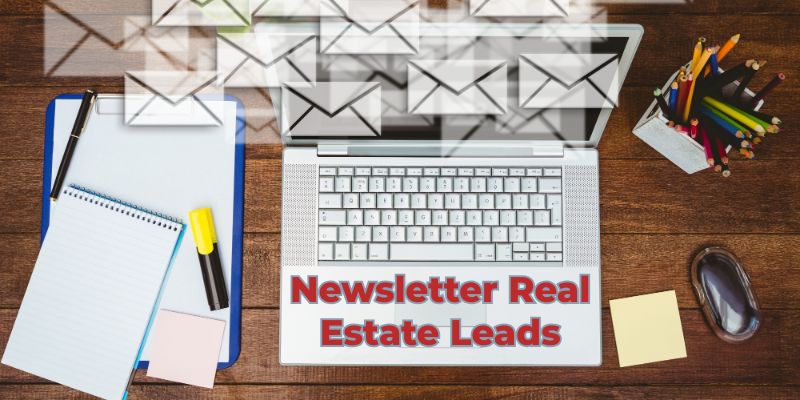Newsletter Real Estate Leads

Progressive real estate agents use newsletters to harness real estate leads daily. But they aren't just sharing news; they're serving up juicy market insights, eye-catching property listings, and expert advice to turn casual readers into customers. While this is a tall order to sustain and replicate from one publication to the next, it becomes infinitely more doable when guided by the following principles.
Nine Guiding Principles To Nurture
Real Estate Newsletters Leads

1. Compelling Content Creation:
- Craft high-quality, informative, and visually appealing content in your newsletters. Include market trends, neighborhood highlights, and expert insights. Content that adds value will attract potential clients to subscribe to your newsletter.
- Continuously provide valuable content that addresses the needs and interests of your audience. Share success stories, client testimonials, and practical tips to establish yourself as a trusted source of information.
2. Segmentation for Personalization:
- Implement audience segmentation based on demographics, preferences, and behaviors. This allows you to develop and tailor content to specific target groups, increasing the likelihood of attracting leads with personalized interests.
- Refine your segmentation strategy as you gather more information about your leads. Send targeted content that speaks directly to the concerns and aspirations of each segment, fostering a sense of personal connection.
3. Strategic Calls-to-Action (CTAs):
- Include clear and enticing CTAs in your newsletters to encourage subscribers to take specific actions. Whether exploring property listings, signing up for consultations, or downloading resources, make sure the CTAs guide them toward becoming leads.
- Strategically place CTAs in newsletters to nurture leads through the sales funnel. Invite them to schedule follow-up consultations, attend open houses, or explore more in-depth resources that align with their real estate journey.
4. Responsive Design for Mobile Users:
- Optimize your newsletters for mobile devices to ensure a seamless experience for subscribers accessing your content on smartphones or tablets. A mobile-friendly design attracts a broader audience, generating more potential leads.
- Continuously test and optimize your newsletter's mobile responsiveness. This ensures leads can easily engage with your content, CTAs, and other interactive elements, fostering ongoing interaction.
5. Consistent Branding and Visual Identity:
- Create newsletters that reflect your brand's visual identity consistently. A well-branded newsletter instills trust and recognition, attracting leads who resonate with your professional image.
- Maintain visual consistency in every newsletter. This reinforces your brand and helps leads remember and identify with your real estate services. Consistent branding builds a sense of familiarity and reliability.
6. Analytics Monitoring for Optimization:
- Implement tracking tools to monitor key metrics such as open, click-through, and subscription rates. Analyze this data to understand what content resonates most with your audience, enabling you to refine your lead generation strategy.
- Use analytics to gain insights into the behavior of your leads. Understand which types of content they engage with most and tailor future newsletters to align with their preferences. This data-driven approach enhances the effectiveness of your lead nurturing efforts.
7. Social Media Integration:
- Promote your newsletters on social media platforms to expand your reach. Encourage your social media followers to subscribe, turning them into potential leads interested in your real estate updates and insights.
- Integrate social sharing buttons in your newsletters, allowing leads to share your content with their networks. This fosters community engagement and can lead to word-of-mouth referrals, nurturing existing leads and generating new ones.
8. Exclusive Offers and Incentives:
- Attract potential clients by offering exclusive deals or incentives through your newsletters. This could include special access to pre-listings, discounted consultation fees, or exclusive market reports. The promise of unique benefits encourages individuals to subscribe and engage.
- Continue to provide exclusive offers to your existing leads, making them feel valued and appreciated. Consider loyalty programs or referral incentives to nurture a sense of community among your subscribers, fostering a long-term connection.
9. Interactive Content Engagement:
- Incorporate interactive elements into your newsletters, such as polls, quizzes, or interactive property showcases. Interactive content demands attention and encourages active engagement, turning passive subscribers into leads who actively participate in the real estate conversation.
- Leverage interactive features to gather more information about your leads' preferences and priorities. Use this data to tailor future content and interactions, demonstrating a commitment to understanding and meeting their specific needs throughout their real estate journey.
Summation:
Real estate agents can effectively generate and develop leads using newsletters as a lead-generation strategy. This approach does two things: it helps attract new leads and fosters lasting relationships with newsletter subscribers, ultimately converting them into loyal customers.
Prewritten Content for Newsletter Real Estate Leads
If you're ready to generate and convert casual newsletter readers into enthusiastic clients, consider using our prewritten content! Being ready-to-go, you can easily customize and tweak sections to perfectly align with your brand voice. This will help you maintain a consistent message and ensure maximum impact with minimal effort. In other words, you'll be able to provide quality information without the time-consuming task of starting from scratch, enabling you to focus on what you do best—growing your real estate business—while we help amplify your lead generation efforts at an impressive value. Check it out and see how effortless it can be!
That's it for now! Happy prospecting!
Home > Real Estate Leads >> Newsletter Real Estate Leads
Nine Ways Image by Freepik







